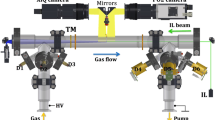Abstract
The results of numerical simulation of the formation and motion of turbulent vortex clouds (puffs) resulting from the blowing of pulsed jets with various initial velocities and durations are given. A model of axisymmetric turbulent flow described by the time-dependent Reynolds equations is adopted. It is shown that, regardless of the initial conditions, a puff which has the shape similar to a sphere develops after the same dimensionless time interval from the instant of jet outflow. In the rest of the space the vortex-induced flow is close to a potential flow. It is found that in the vortices the velocity profiles in the axial and transverse directions are close to self-similar profiles and similar each other for various conditions of outflow of pulsed jets. The time dependences of the geometric and kinematic characteristics of puffs, namely, the location of the cloud center (points with the maximum velocity) and the radius of a sphere equivalent in volume to the puff, as well as the maximum and mean velocities, are given and analyzed. For the jet outflow conditions considered, the characteristics of puffs turn out to be similar.









Similar content being viewed by others
REFERENCES
Nazaroff, W.W., Indoor aerosol science aspects of SARS-CoV-2 transmission, Indoor Air, 2022, vol. 32, no. 1, pp. 1–13. https://doi.org/10.1111/ina.12970
Bu, Y., Ooka, R., Kikumoto, H., and Oh, W., Recent research on expiratory particles in respiratory viral infection and control strategies: A review, Sustainable Cities and Society, 2021, vol. 73, pp. 1–16. https://doi.org/10.1016/j.scs.2021.103106
Gupta, J.K., Lin, C.-H., and Chen, Q., Flow dynamics and characterization of a cough, Indoor Air, 2009, vol. 19, no. 6, pp. 517–525. https://doi.org/10.1111/j.1600-0668.2009.00619.x
Bourouiba, L., The fluid dynamics of disease transmission, Ann. Rev. Fluid Mech., 2021, vol. 53, pp. 473–508. https://doi.org/10.1146/annurev-fluid-060220-113712
Mazzino, A. and Rosti, M.E., Unraveling the secrets of turbulence in a fluid puff, Phys. Rev. Lett., 2021, vol. 127, no. 9, pp. 1–6. https://doi.org/10.1103/PhysRevLett.127.094501
Fabregat, A., Gisbert, F., Vernet, A., Dutta, S., Mittal, K., and Pallarès, J., Direct numerical simulation of the turbulent flow generated during a violent expiratory event, Phys. Fluids, 2021, vol. 33, pp. 1–12. https://doi.org/10.1063/5.0042086
Fabregat, A., Gisbert, F., Vernet, A., Ferré, J.A., Mittal, K., Dutta, S., and Pallarès, J., Direct numerical simulation of turbulent dispersion of evaporative aerosol clouds produced by an intense expiratory event, Phys. Fluids, 2021, vol. 33, pp. 1–13. https://doi.org/10.1063/5.0045416
Ghaem-Maghami, E. and Johari, H., Concentration field measurements within isolated turbulent puffs, ASME. J. Fluids Eng., 2007, vol. 129, pp. 194–199. https://doi.org/10.1115/1.2409348
Akhmetov, D.G., Vortex Rings, Berlin: Springer, 2009; Novosibirsk: GEO, 2007.
Nikulin, V.V., Mass exchange between the atmosphere of turbulent vortex ring and the surrounding medium, Fluid Dyn., 2021, vol. 56, no. 4, pp. 473–480. https://doi.org/10.1134/S0015462821040108
Andriani, R., Coghe, A., and Cossali, G.E., Near-field entrainment in unsteady gas jets and diesel sprays: A comparative study, in: Symposium (International) on Combustion, 1996, vol. 26, no. 2, pp. 2549–2556. https://doi.org/10.1016/s0082-0784(96)80087-7.
Kovasznay, L.S.G., Fujita, H., and Lee, R.L., Unsteady turbulent puffs, Adv. Geophys., 1975, vol. 18, Part B, pp. 253–263. https://doi.org/10.1016/S0065-2687(08)60584-1
Richards, J.M., Puff motions in unstratified surroundings, J. Fluid Mech., 1965, vol. 21, no. 1, pp. 97–106. https://doi.org/10.1017/S002211206500006X
Sangras, R., Kwon, O.C., and Faeth, G.M., Self-preserving properties of unsteady round nonbuoyant turbulent starting jets and puffs in still fluids, ASME. J. Heat Transfer, 2002, vol. 124, no. 3, pp. 460–469. https://doi.org/10.1115/1.1421047
Ghaem-Maghami, E. and Johari, H., Velocity field of isolated turbulent puffs, Phys. Fluids, 2010, vol. 22, pp. 1–13. https://doi.org/10.1063/1.3504378
Zasimova M.A., Ivanov, N.G., and Ris, V.V., Non-stationary diffusion of viral particles in a pulsed jet formed during coughing, in: XVI Minsk International Forum on Heat and Mass Transfer. Abstracts and Messages. Minsk: ITMO im. A.V. Lykov, 2022, pp. 251–255.
Zasimova M., Ris V., and Ivanov N., CFD modelling of a pulsed jet formed during an idealized isolated cough, in: E3S Web of Conferences, 2022, v. 356, pp. 1–4. https://doi.org/10.1051/e3sconf/202235605024
Zasimova M.A., Ivanov, N.G., and Ris, V.V., URANS and LES simulation of the initial stage of propagation of a droplet-containing air jet characteristic of acute respiratory phenomena, in: Materials of the 8th RNKT, Moscow: Izd. MEI, 2022, vol. 1, pp. 435–438.
Pallarès, J., Fabregat, A., Lavrinenko, A., et al., Numerical simulations of the flow and aerosol dispersion in a violent expiratory event: Outcomes of the “2022 International Computational Fluid Dynamics Challenge on violent expiratory events,” Phys. Fluids, 2023, vol. 35, pp. 1–22. https://doi.org/10.1063/5.0143795
Yakhot,V. and Orszag, S.A., Renormalization group analysis of turbulence. I. Basic theory, J. Sci. Comput., 1986, vol. 1, pp. 3–51. https://doi.org/10.1007/BF01061452
Yakhot, V., Orszag, S.A., Thangam, S., Gatski, T.B., and Speziale, C.G., Development of turbulence models for shear flows by a double expansion technique, Phys. Fluids, 1992, vol. 4, pp. 1510–1520. https://doi.org/10.1063/1.858424
Batchelor, G.K., An Introduction to Fluid Dynamics, Cambridge: Cambridge University Press, 2000.
Glezer, A. and Coles, D., An experimental study of a turbulent vortex ring, J. Fluid Mech., 1990, vol. 211, pp. 243–283. https://doi.org/10.1017/S0022112090001562
Author information
Authors and Affiliations
Corresponding author
Ethics declarations
The authors wish to thank Prof. E.M. Smirnov for valuable advices and comments.
Additional information
Translated by E.A. Pushkar
Rights and permissions
About this article
Cite this article
Zasimova, M.A., Ris, V.V. & Ivanov, N.G. Numerical Simulation of the Formation and Motion of Turbulent Vortex Clouds (Puffs). Fluid Dyn 58, 882–893 (2023). https://doi.org/10.1134/S0015462823601316
Received:
Revised:
Accepted:
Published:
Issue Date:
DOI: https://doi.org/10.1134/S0015462823601316



